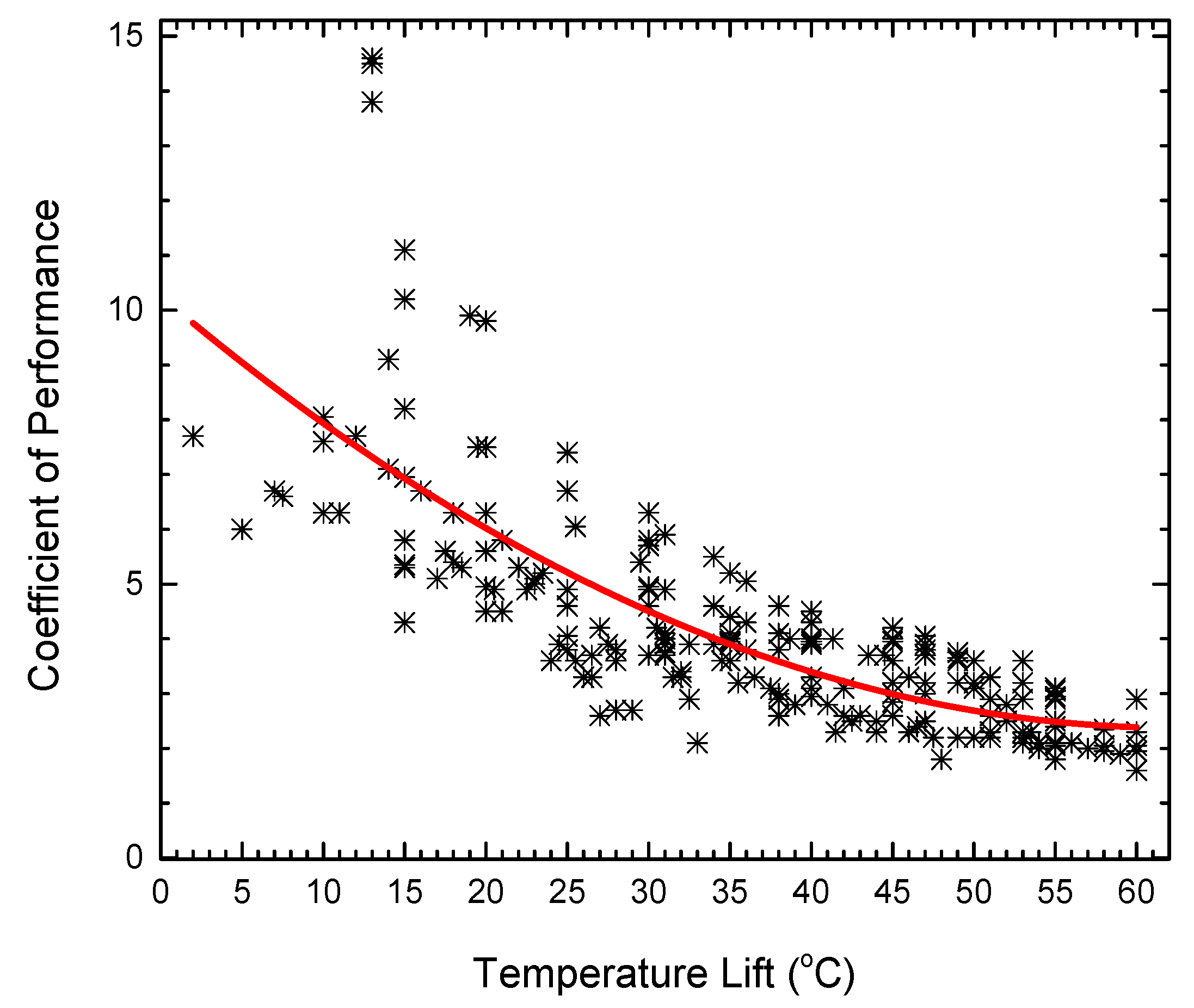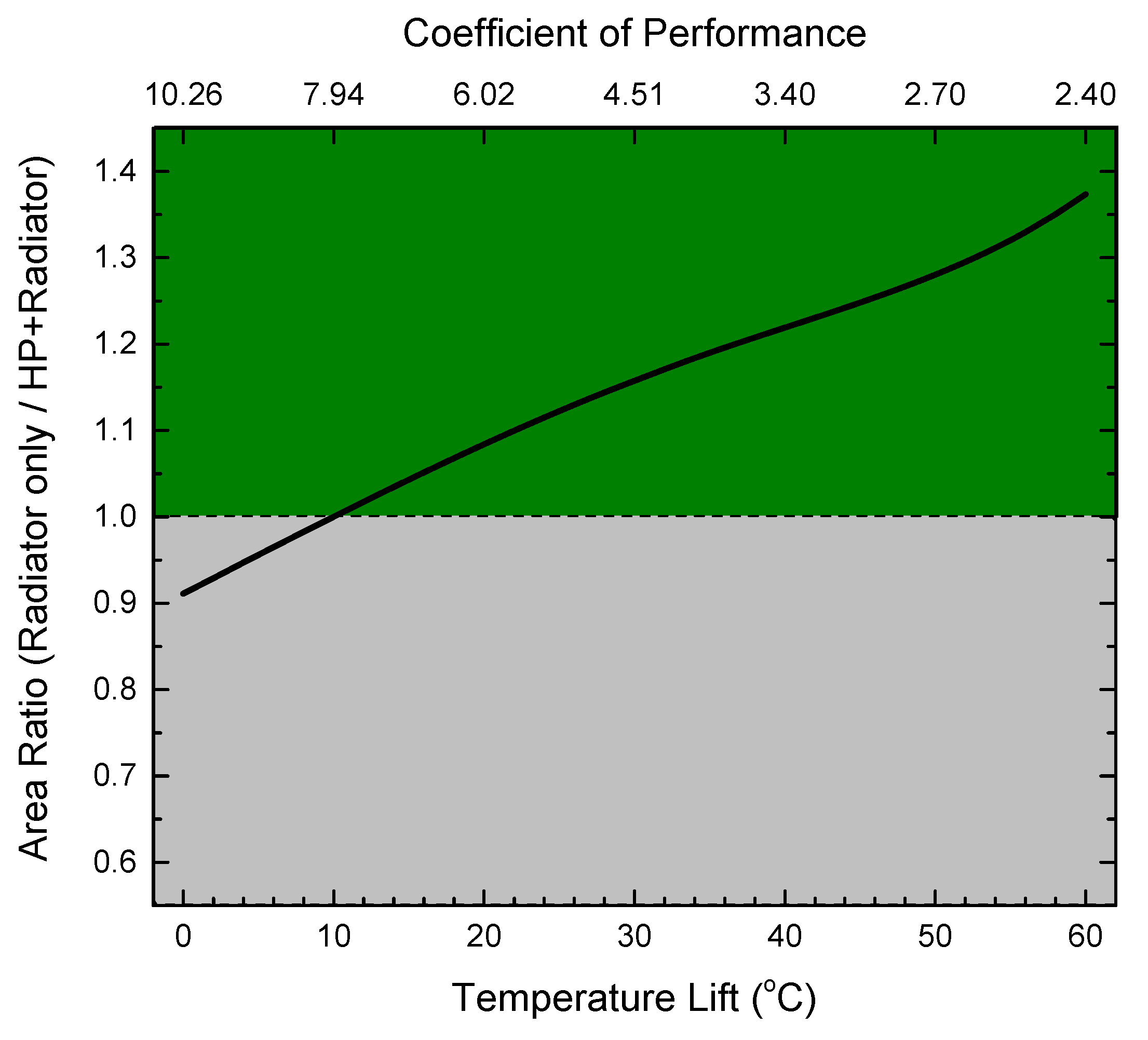Assessing the Potential of Heat Pumps to Reduce the Radiator Size on Small Satellites
Abstract
:1. Introduction
2. Materials and Methods
2.1. Theoretical Radiator Size Calculations
2.2. Heat-Pump Performance Data
2.3. Radiator Size Reduction Potential
3. Results
3.1. Theoretical Radiator Size Calculations
3.2. Heat-Pump Performance Data
3.3. Radiator Size Reduction Potential
3.4. Discussion
4. Conclusions
Author Contributions
Funding
Data Availability Statement
Acknowledgments
Conflicts of Interest
References
- Available online: http://www.satellitemarkets.com/ (accessed on 24 February 2023).
- Sharma, C.S.; Zimmermann, S.; Tiwari, M.K.; Michel, B.; Poulikakos, D. Optimal thermal operation of liquid-cooled electronic chips. Int. J. Heat Mass Transf. 2012, 55, 1957–1969. [Google Scholar] [CrossRef]
- Tua, Y.; Chu, R.; Janna, W. Thermal Management of Micro-electronic Equipment: Heat Transfer Theory, Analysis Methods, and Design Practices. Appl. Mech. Rev. 2003, 56, B46–B48. [Google Scholar]
- Donabedian, M.; Gilmore, D. Spacecraft Thermal Control Handbook; Aerospace Press: El Segundo, CA, USA, 2003; p. 253. [Google Scholar]
- Pierre, M.S. Zero Gravity (Position Insensitive) Low-Temperature Multi-Component Refrigerator. U.S. Patent 4,689,964, 1 September 1987. [Google Scholar]
- Woolley, R. Separation Method and Apparatus for a Liquid and Gas Mixture. U.S. Patent 5,218,832, 15 June 1993. Available online: https://patents.google.com/patent/US5218832A/en?oq=U.S.+Patent+5218832 (accessed on 24 February 2023).
- Messaros, M.C.; Verstracte, J.L. Design and development of a high reliability oil lubricated compressor for a space Borne Joule-Thompson cryocooler. In Proceedings of the International Compressor Engineering Conference at Purdue University, West Lafayette, IN, USA, 19–22 July 1994. [Google Scholar]
- Nikanpour, D.; Aidoun, Z.; De-Parolis, L.; Lebru, A. Advanced heat pumps for interplanetary spacecraft/lander thermal control. In Proceedings of the Sixth European Symposium on Space Environmental Control Systems, Noordwijk, The Netherlands, 20–22 May 1997. [Google Scholar]
- Domitrovic, R.E.; Chen, F.C.; Mei, V.C.; Spezia, A.L. Microgravity heat pump for space station thermal management. Habitation 2003, 9, 79–88. [Google Scholar] [CrossRef]
- Cole, G.; Scaringe, R.; Grzyll, L.; Ewert, M.K. Development of a gravity-insensitive heat pump for lunar applications. In Proceedings of the Space Technology and Applications (STAIF), Albuquerque, NM, USA, 11–15 February 2007; Volume 2006. [Google Scholar]
- Bell, I.H.; Wronski, J.; Quoilin, S.; Lemort, V. Pure and Pseudo-pure Fluid Thermophysical Property Evaluation and the Open-Source Thermophysical Property Library CoolProp. Ind. Eng. Chem. Res. 2014, 53, 2498–2508. [Google Scholar] [CrossRef] [PubMed]
- Brendel, L.P.; Caskey, S.L.; Ewert, M.K.; Hengeveld, D.; Braun, J.E.; Groll, E.A. Review of vapor compression refrigeration in microgravity environments. Int. J. Refrig. 2021, 123, 169–179. [Google Scholar] [CrossRef]
- Brendel, L.P.; Caskey, S.L.; Ewert, M.K.; Lee, F.K.; Braun, J.E.; Groll, E.A. Vapor compression refrigeration testing on parabolic flights: Part 1—Cycle stability. Int. J. Refrig. 2022, 136, 152–161. [Google Scholar] [CrossRef]
- Brendel, L.P.; Caskey, S.L.; Braun, J.E.; Groll, E.A. Vapor compression refrigeration testing on parabolic flights: Part 2—Heat exchanger performance. Int. J. Refrig. 2021, 135, 254–260. [Google Scholar] [CrossRef]
- Pan, C.; Ziviani, D.; Braun, J.E. Performance evaluation of a vapor-compression-cycle based heat pump system for a lunar habitat under the impact of dust deposits on the coupled radiators. Acta Astronaut. 2022, 194, 22–33. [Google Scholar] [CrossRef]
- Piedra, S.; Torres, M.; Ledesma, S. Thermal Numerical Analysis of the Primary Composite Structure of a CubeSat. Aerospace 2019, 6, 97. [Google Scholar] [CrossRef]
- Tachikawa, S.; Nagano, H.; Ohnishi, A.; Nagasaka, Y. Advanced Passive Thermal Control Materials and Devices for Spacecraft: A Review. Int. J. Thermophys. 2022, 43, 91. [Google Scholar] [CrossRef]
- Sanner, B.; Karytsas, C.; Mendrinos, D.; Rybach, L. Current status of ground source heat pumps and underground thermal energy storage in Europe. Geothermics 2003, 32, 579–588. [Google Scholar] [CrossRef]
- Sanaye, S.; Niroomand, B. Horizontal ground coupled heat pump: Thermal-economic modeling and optimization. Energy Convers. Manag. 2010, 51, 2600–2612. [Google Scholar] [CrossRef]
- Heat Pump Manufacturer’s Data. Available online: https://sparenergi.dk/ (accessed on 24 March 2023).
- Heat Pump Manufacturer’s Data. Available online: https://energyfaculty.com/heat-pump-data/ (accessed on 24 February 2023).
- Gillan, B. Investigating the Potential of Low Exergy Thermal Sources to Improve the COP of Heat Pumps. Master’s Thesis, University of Strathclyde, Glasgow, UK, 2016. [Google Scholar]
- Haller, M.Y.; Haberl, R.; Carbonell, D.; Philippen, D.; Frank, E. SOL-HEAP. Solar and Heat Pump Combisystems; Institut für Solartechnik SPF, Hochschule für Technik HSR: Rapperswil, Switzerland, 2014. [Google Scholar]
- Pospíšil, J.; Špiláček, M.; Charvát, P. Seasonal COP of an Air-to-Water Heat Pump when Using Predictive Control Preferring Power Production from Renewable Sources in the Czech Republic. Energies 2019, 12, 3236. [Google Scholar] [CrossRef]
- Ruhnau, O.; Hirth, L.; Praktiknjo, A. Time series of heat demand and heat pump efficiency for energy system modeling. Sci. Data 2019, 6, 189. [Google Scholar] [CrossRef] [PubMed]
- Aguilar, F.; Aledo, S.; Vicente-Quiles, P. Experimental study of the solar photovoltaic contribution for the domestic hot water production with heat pumps in dwellings. Appl. Therm. Eng. 2016, 101, 379–389. [Google Scholar] [CrossRef]
- Meggers, F.; Ritter, V.; Goffin, P.; Baetschmann, M.; Leibundgut, H. Low exergy building systems implementation. Energy 2012, 41, 48–55. [Google Scholar] [CrossRef]
- Mohanraj, M.; Belyayev, Y.; Jayaraj, S.; Kaltayev, A. Research and developments on solar assisted compression heat pump systems—A comprehensive review (Part-B: Applications). Renew. Sustain. Energy Rev. 2018, 83, 124–155. [Google Scholar] [CrossRef]
- Kuang, Y.; Wang, R. Performance of a multi-functional direct-expansion solar assisted heat pump system. Sol. Energy 2006, 80, 795–803. [Google Scholar] [CrossRef]
- Ito, S.; Miura, N.; Wang, K. Performance of a heat pump using direct expansion solar collectors. Sol. Energy 1999, 65, 189–196. [Google Scholar] [CrossRef]
- Torres-Reyes, E.; de Gortari, J.C. Optimal performance of an irreversible solar-assisted heat pump. Exergy Int. J. 2001, 1, 107–111. [Google Scholar] [CrossRef]
- Chata, F.G.; Chaturvedi, S.; Almogbel, A. Analysis of a direct expansion solar assisted heat pump using different refrigerants. Energy Convers. Manag. 2005, 46, 2614–2624. [Google Scholar] [CrossRef]
- Izquierdo, M.; de Agustín-Camacho, P. Solar heating by radiant floor: Experimental results and emission reduction obtained with a micro photovoltaic–heat pump system. Appl. Energy 2015, 147, 297–307. [Google Scholar] [CrossRef]
- Moreno_Rodriguez, A.; González-Gil, A.; Izquierdo, M.; Hernando, N.G. Theoretical model and experimental validation of a direct-expansion solar assisted heat pump for domestic hot water applications. Energy 2012, 45, 704–715. [Google Scholar] [CrossRef]
- Li, Y.; Wang, R.; Wu, J.; Xu, Y. Experimental performance analysis and optimization of a direct expansion solar-assisted heat pump water heater. Energy 2007, 32, 1361–1374. [Google Scholar] [CrossRef]
- Gasser, L.; Flück, S.; Kleingries, M.; Meier, C.; Bätschmann, M. Wellig High efficiency heat pumps for low temperature lift applications. In Proceedings of the 12th IEA Heat Pump Conference, Rotterdam, The Netherlands, 15–18 May 2017. [Google Scholar]
- Zhang, J.; Wang, R.; Wu, J. System optimization and experimental research on air source heat pump water heater. Appl. Therm. Eng. 2007, 27, 1029–1035. [Google Scholar] [CrossRef]
- Trillat-Berdal, V.; Souyri, B.; Fraisse, G. Experimental study of a ground-coupled heat pump combined with thermal solar collectors. Energy Build. 2006, 38, 1477–1484. [Google Scholar] [CrossRef]
- Sarbu, I.; Sebarchievici, C. General review of ground-source heat pump systems for heating and cooling of buildings. Energy Build. 2014, 70, 441–454. [Google Scholar] [CrossRef]
- Available online: https://ii-vi.com/thermoelectrics/ (accessed on 31 March 2023).
- Available online: https://lairdthermal.com/products/thermoelectric-cooler-modules (accessed on 31 March 2023).
- Available online: https://www.europeanthermodynamics.com/products/thermoelectric-modules/peltier-cooler (accessed on 31 March 2023).
- Bennett, N.S.; Byrne, D.; Cowley, A.; Neophytou, N. Dislocation loops as a mechanism for thermoelectric power factor enhancement in silicon nano-layers. Appl. Phys. Lett. 2016, 109, 173905. [Google Scholar] [CrossRef]
- Kitanovski, A.; Plaznik, U.; Tomc, U.; Poredoš, A. Present and future caloric refrigeration and heat-pump technologies. Int. J. Refrig. 2015, 57, 288–298. [Google Scholar] [CrossRef]
- Ulpiani, G.; Bruederlin, F.; Weidemann, R.; Ranzi, G.; Santamouris, M.; Kohl, M. Upscaling of SMA film-based elastocaloric cooling. Appl. Therm. Eng. 2020, 180, 115867. [Google Scholar] [CrossRef]
- Aprea, C.; Greco, A.; Maiorino, A.; Masselli, C. A comparison between different materials in an active electrocaloric regenerative cycle with a 2D numerical model. Int. J. Refrig. 2016, 69, 369–382. [Google Scholar] [CrossRef]
- Aprea, C.; Greco, A.; Maiorino, A.; Masselli, C. The use of barocaloric effect for energy saving in a domestic refrigerator with ethylene-glycol based nanofluids: A numerical analysis and a comparison with a vapor compression cooler. Energy 2019, 190, 116404. [Google Scholar] [CrossRef]
- Johra, H.; Filonenko, K.; Marszal-Pomianowska, A.; Heiselberg, P.; Veje, C.; Dall’olio, S.; Engelbrecht, K.; Bahl, C. Numerical Simulation of a Magnetocaloric Heat Pump for Domestic Hot Water Production in Residential Buildings. In Proceedings of the 16th IBPSA Conference, Rome, Italy, 2–4 September 2019; pp. 1948–1955. Available online: http://www.ibpsa.org/proceedings/BS2019/BS2019_210828.pdf (accessed on 24 February 2023).




Disclaimer/Publisher’s Note: The statements, opinions and data contained in all publications are solely those of the individual author(s) and contributor(s) and not of MDPI and/or the editor(s). MDPI and/or the editor(s) disclaim responsibility for any injury to people or property resulting from any ideas, methods, instructions or products referred to in the content. |
© 2023 by the authors. Licensee MDPI, Basel, Switzerland. This article is an open access article distributed under the terms and conditions of the Creative Commons Attribution (CC BY) license (https://creativecommons.org/licenses/by/4.0/).
Share and Cite
Bennett, N.S.; Lim, B. Assessing the Potential of Heat Pumps to Reduce the Radiator Size on Small Satellites. Energies 2023, 16, 4010. https://doi.org/10.3390/en16104010
Bennett NS, Lim B. Assessing the Potential of Heat Pumps to Reduce the Radiator Size on Small Satellites. Energies. 2023; 16(10):4010. https://doi.org/10.3390/en16104010
Chicago/Turabian StyleBennett, Nick S., and Brian Lim. 2023. "Assessing the Potential of Heat Pumps to Reduce the Radiator Size on Small Satellites" Energies 16, no. 10: 4010. https://doi.org/10.3390/en16104010
APA StyleBennett, N. S., & Lim, B. (2023). Assessing the Potential of Heat Pumps to Reduce the Radiator Size on Small Satellites. Energies, 16(10), 4010. https://doi.org/10.3390/en16104010





